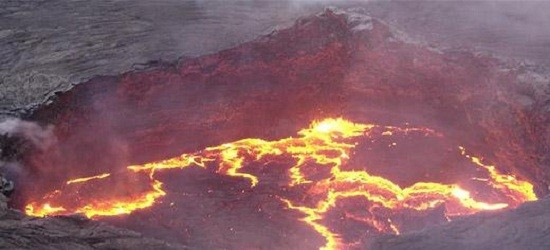Scientists Close To Predicting Volcanic Eruptions

Scientists are close to predicting large volcanic eruptions, thanks to their plumbing system, an international team of scientists has found after working in Afar (Ethiopia) and Iceland - the only places where mid-ocean ridges appear above sea level.
Volcanic ridges occur when tectonic plates "rift" or pull apart; that is when the magma injects itself out of the brittle upper crust and when the erupting lava cools down it forms a new crust.
When analysing these crusts, they found that magma travels through chambers. By studying the locations and behaivour of the chambers; they can easily predict volcanic eruptions. Magma chambers work like plumbing systems, channeling pressurised magma through networks of underground "pipes". This magma moves through the geological plumbing network, by finding out where magma chambers lie and how they behave can help identify early warning signs of impending eruptions.
Scientists had found a plumbing network when they were analysing some images taken by the European Space Agency satellite Envisat that showed how the ground moved before, during and after eruptions. Using this data, they built and tested computer models to find out how rifting occurs.
One piece of the data showed that magma chambers that fed an eruption in November 2008 in the Afar rift of Northern Ethiopia were only about 1 km below the ground. The standard model had predicted a depth of more than 3 km.
Researchers say that it is highly unusual for magma chambers to lie in shallow depths on slow spreading centres such as the Afar rift, where tectonic plates pull apart at about the same speed as human fingernails grow.
Dr Carolina Pagli from the University of Leeds' School of Earth and Environment, who led the study, says: "It was a complete surprise to see that a magma chamber could exist so close to the earth's surface in an area where the tectonic plates move apart so slowly. The results have changed the way we think about volcanoes."
According to researchers, they had noticed that the ground started "uplifting" (elevating) four months before the eruption, due to new magma increasing pressure in one of the underground chambers. By understanding such precursory signals it will be easy to predict future eruptions.
"The dramatic events we have been witnessing in Afar in the past six years are transforming our understanding of how the crust grows when tectonic plates pull apart. Our work in one of the hottest place on Earth is having a direct impact on our understanding of eruptions from the frozen volcanoes of Iceland," said Dr Tim Wright from the School of Earth and Environment, who leads the international Afar Rift Consortium.
© Copyright IBTimes 2025. All rights reserved.





















